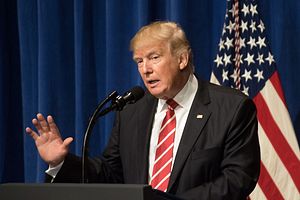On Monday, the White House released the upcoming itinerary for U.S. President Donald J. Trump’s highly anticipated first trip to the Asia-Pacific. The trip, which will last from November 3 to 14, will be the second major foreign trip by Trump, following his early summer trip to the Middle East and Europe. Trump will visit a range of countries in Southeast and Northeast Asia, including U.S. allies Japan, South Korea, and the Philippines, in addition to China and Vietnam.
Trump’s trip will begin on November 3 in Hawaii, where he will visit Pearl Harbor and be briefed by U.S. Pacific Command, according to a White House statement. From there, he will head to Japan on November 5, where he will meet with Prime Minister Shinzo Abe, who is expected to remain in power in Japan following the upcoming snap elections. Abe’s Liberal Democratic Party appears poised for a landslide victory. North Korea is expected to feature prominently for Trump in Japan — and, indeed, across the region.
In Japan, Trump will meet the families of Japanese citizens abducted by North Korea, the White House also said. Trump may also follow up on ongoing bilateral U.S.-Japan talks on trade. On Monday, U.S. Vice President Mike Pence met his Japanese counterpart Taro Aso to carry out the second round of talks in a special channel the two sides set up during Abe’s February visit to the United States.
Following the Japan leg of his trip, Trump will visit South Korea on November 7, where he will meet with South Korean President Moon Jae-in. Trump will address the South Korean National Assembly. Trump’s time in South Korea will also be focused on isolating North Korea and on the U.S.-South Korea alliance. Trump is also expected to visit the Demilitarized Zone (DMZ) separating the two Koreas. According to South Korean press reports, Trump may undertake some sort of gesture toward North Korea at the DMZ.
Following his visits to the United States’ two Northeast Asian allies, Trump will head to Beijing for his second bilateral summit with Chinese leader Xi Jinping following their meeting in April. Xi will be fresh out of the 19th Party Congress, with potentially a greater appetite for foreign policy risk-taking. The White House hasn’t expanded on the agenda in China for Trump, but North Korea will no doubt feature prominently. Trade, too, will be an important component of Trump’s time in China.
After Beijing, Trump will head south to Vietnam, where the Asia-Pacific Economic Cooperation (APEC) Leaders’ Meeting will be taking place. Trump is slated to address the APEC Chief Executive Officer Summit. This speech could be the first articulation of the Trump administration’s strategy for the Asia-Pacific region. The White House has identified the theme as focusing on the United States’ “vision for a free and open Indo-Pacific region.” The speech may articulate a U.S. response to China’s Belt and Road Initiative.
Aside from his APEC engagements, Trump will meet with Vietnamese President Tran Dai Quang in Vietnam. The bilateral agenda has not been clarified in any detail, but it is likely that Trump will continue the rapprochement between Hanoi and Washington that was considerably accelerated by the Obama administration during its final year in office.
The final leg of Trump’s visit will take him to the Philippines, another U.S. treaty ally in Asia. There, Trump will meet with President Rodrigo Duterte in addition to attending a range of Association of Southeast Asian Nations (ASEAN) Summit meetings. (This year is the 50th anniversary of ASEAN and the Philippines currently chairs the ten-member regional body.) The bilateral agenda for the Duterte meeting has not been specified yet, but counterterrorism cooperation will likely be high on the list given U.S. assistance to the Philippines in the Marawi City siege, which began early this summer and has now drawn down.
Trump’s Asia trip will no doubt test this U.S. administration, which continues to have critical senior diplomatic posts vacant in the State Department. The trip will present an opportunity for the Trump administration to show that it can walk and chew gum on Asia policy — in other words, that North Korea and trade policy aren’t monopolizing the administration’s strategic energies.
Questions ranging from U.S. policy toward the South China Sea to the future of regional order continue to linger. This trip will be the best opportunity the Trump administration gets this year to set the record straight on where it stands on these and other important questions in the Asia-Pacific.

































